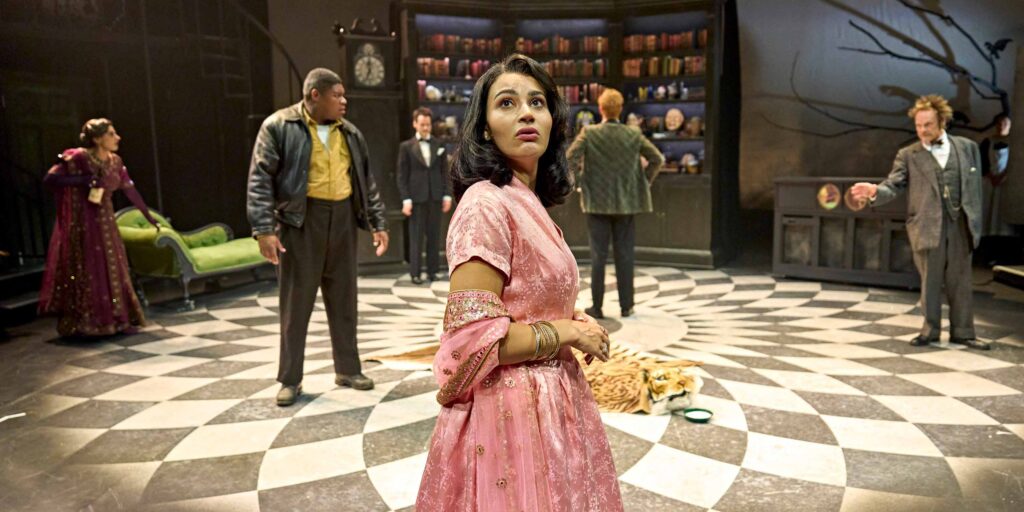
The Cat and the Canary
Chichester Minerva Theatre
Director: Paul Hunter
Original play by: John Willard
Adapted by: Carl Grose
A co-production with Told by an Idiot
In 1922, John Willard wrote his most famous work, The Cat and the Canary. Made into a silent picture in 1927, then as a talkie in 1930, the play epitomised the gothic horror traditions seen in novels such as ‘Dracula’, and ‘The Castle of Otranto’, whilst combining the ‘who-dun-it’ style and charm of Agatha Christie. This production, a co-production between Chichester and the renowned theatre company, Told by an Idiot, invites us into the narrative Willard so cleverly wrote over 100 years ago. Following a small family reunion after the death of a relative, the relations find themselves locked in the manor house on a cold, wintery night with a mad-man on the loose, but not everything is quite as it seems…
Last night, the Minerva Theatre was entirely transformed to that of a dilapidated, boarded up manor house, crows and cobwebs lurking at every turn. Eerie sound effects, wind howling and creaks in the corners, invited the audience in to the space as we prepared ourselves for the night ahead, and what a night it was. The relations we are introduced to are an eccentric mix; a boxer, a thriller novelist, an actor and socialites, all brought together by Nick Haverson as Crosby, the executor of their relative’s will. Haverson is exceptional, most notably at his role-playing abilities. Beginning as Crosby, he then transforms into the local psychiatric hospital’s guard to warn of an escaped patient, and continues to portray other characters such as the local Scottish doctor sent to check on the relatives. Combining moments of clowning, with some excellent drum playing, Haverson truly was an all-round performer here.
Lucy McCormick plays Annabelle West, the leading lady and focus of the narrative. McCormick was wonderful, starting off as a well-spoken novelist whose relatives are in awe of, and slowly morphing into a hysterical, paranoid figure, as the spooky goings on of the house close in on her.
Calum Finlay also stood out as the sweet and gentle relative, Paul, (although his shift in character towards the end was brilliant), with such energy and humour that had the audience in stitches.
The rest of the cast were equally superb, with Tarinn Callender as Harry Blythe, the confident boxer of the family, Lena Kaur as Surinda Ghosh aka Susan Sillsby (drunk Susan was hilarious), Heather Lai as the silent and spooky Dora, Nikhita Lesler as Cicily (a sweet and excitable relative), Will Merrick as Charlie the actor (reciting moments of Hamlet intensely to the dismay of his relatives) and the brilliant Hayley Carmichael as Mrs Pleasant, the slightly creepy and solemn housekeeper.
The set itself felt like another player in the show; designed by Angela Davies, each corner, shelf, cupboard, clock and piano was used ingeniously. The shock and spookiness of the show was also used inventively, subverting the expectations of traditional horror, both in sound effects (designed by Adrienne Quartly) and staging elements. Whilst I wasn’t particularly fond of the modern music used at times, sound is vital in creating suspense, as we see in traditional horror films; the building of tension and slow drones of fear come together to instil the required experience. Pupperty was also used, designed by Lyndie Wright, and paid recognition to the use of dolls in horror, such as the evil doll Chucky. The revelation at the end, could have gone further in spookiness; the whole show had us on the edge of our seats and I felt the last scenes fell a little short of achieving the same feeling.
The style of this show takes elements of the play’s gothic horror roots, its transformation into silent film, murder mystery tales and comedic meta-theatre. The use of film on stage was a wonderful homage to the era of black and white silent films, with a special appearance by Inside No 9’s Reece Shearsmith. Although I wasn’t convinced the use of meta-theatre worked for this production, it proved entertaining for the audience, and increased the distortion of reality/fiction. On an analytical plane, I thought the show excelled in questioning and examining fear; how it is manufactured, how we as audiences consume it, and how it is portrayed in theatre.
The Cat and the Canary is a brilliant blend of comedy and spooks, and I think Chichester has something special lurking in their Minerva Theatre. A unique piece of work, it is an eccentric murder mystery filled with wonderful characters, a fabulous set and enough bumps and jumps to keep you thrilled throughout. And a word to the wise, as Mrs Pleasant warns us, do not be a canary in fear of the cat lurking around the corner…
The Cat and the Canary is playing now in Chichester Festival Theatre’s Minerva Theatre until the 26th of October.
Reviewer: Lily Sitzia
Photo: Manuel Harlen